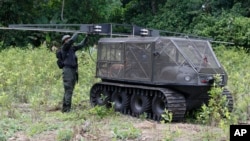Colombia's President Juan Manuel Santos on Tuesday authorized the use of drones to spray coca leaves at low altitude using the herbicide glyphosate as part of the Andean nation's battle to eliminate the plant's use in cocaine production.
Santos, who leaves office in August, approved the measure a day after the United States said Colombia's coca cultivation had increased 11 percent to 209,000 hectares (516,450 acres) in 2017 and potential cocaine output had risen 19 percent to 921 metric tons a year.
Colombia, one of the world's largest cocaine producers, suspended aerial spraying using glyphosate in 2015 after the World Health Organization linked it to cancer.
Glyphosate is a key ingredient in the world's most widely used herbicide, Roundup, produced by Monsanto Co.
Santos' decision was made at a meeting in Bogota of the National Narcotics Council, a government body that designs strategies to fight drug trafficking.
"Today we discussed the use of so-called drones, unmanned aircraft that due to their height simulate ground, not aerial, fumigation," said Santos, who will be replaced by right-wing President-elect Ivan Duque.
Low-flying drones limit the dangers associated with glyphosate, Santos said, adding the government aims to eradicate 110,000 hectares (271,816 acres) of coca this year.
Colombia has been plagued by violence associated with drug trafficking for decades. Marxist rebel groups, right-wing paramilitaries and crime gangs make billions of dollars selling cocaine overseas.
The government signed a peace accord in late 2016 with the Revolutionary Armed Forces of Colombia (FARC), which was heavily involved in coca production and cocaine trafficking. Since the group demobilized, many new gangs have moved in and taken over its lucrative business and trafficking routes.
The United States, the main consumer of Colombian cocaine, supports the government's fight against the illegal drug trade.
Between 2000 and 2015, Colombia received $10 billion for military and social programs, although aid has since been reduced to about $400 million annually.







